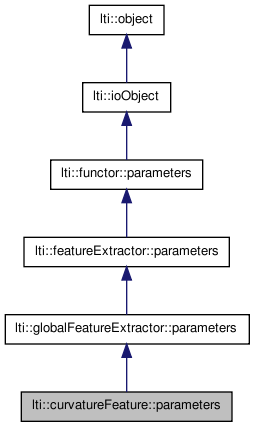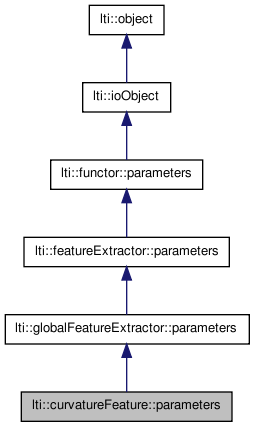

|
latest version v1.9 - last update 10 Apr 2010 |
|
the parameters for the class curvatureFeature More...
#include <ltiCurvatureFeature.h>


Public Member Functions | |
| parameters () | |
| parameters (const parameters &other) | |
| ~parameters () | |
| const char * | getTypeName () const |
| parameters & | copy (const parameters &other) |
| parameters & | operator= (const parameters &other) |
| virtual functor::parameters * | clone () const |
| virtual bool | write (ioHandler &handler, const bool complete=true) const |
| virtual bool | read (ioHandler &handler, const bool complete=true) |
Public Attributes | |
| int | gaussianSize |
| float | gaussianVariance |
| float | deltaLength |
| float | relevanceThreshold |
| bool | normalize |
| float | lowerLimit |
| float | upperLimit |
| int | size |
the parameters for the class curvatureFeature
| lti::curvatureFeature::parameters::parameters | ( | ) |
default constructor
Reimplemented from lti::globalFeatureExtractor::parameters.
| lti::curvatureFeature::parameters::parameters | ( | const parameters & | other | ) |
copy constructor
| other | the parameters object to be copied |
Reimplemented from lti::globalFeatureExtractor::parameters.
| lti::curvatureFeature::parameters::~parameters | ( | ) | [virtual] |
destructor
Reimplemented from lti::globalFeatureExtractor::parameters.
| virtual functor::parameters* lti::curvatureFeature::parameters::clone | ( | ) | const [virtual] |
returns a pointer to a clone of the parameters
Reimplemented from lti::globalFeatureExtractor::parameters.
| parameters& lti::curvatureFeature::parameters::copy | ( | const parameters & | other | ) |
copy the contents of a parameters object
| other | the parameters object to be copied |
Reimplemented from lti::globalFeatureExtractor::parameters.
| const char* lti::curvatureFeature::parameters::getTypeName | ( | ) | const [virtual] |
returns name of this type
Reimplemented from lti::globalFeatureExtractor::parameters.
| parameters& lti::curvatureFeature::parameters::operator= | ( | const parameters & | other | ) |
copy the contents of a parameters object
| other | the parameters object to be copied |
| virtual bool lti::curvatureFeature::parameters::read | ( | ioHandler & | handler, | |
| const bool | complete = true | |||
| ) | [virtual] |
read the parameters from the given ioHandler
| handler | the ioHandler to be used | |
| complete | if true (the default) the enclosing begin/end will be also written, otherwise only the data block will be written. |
Reimplemented from lti::functor::parameters.
| virtual bool lti::curvatureFeature::parameters::write | ( | ioHandler & | handler, | |
| const bool | complete = true | |||
| ) | const [virtual] |
write the parameters in the given ioHandler
| handler | the ioHandler to be used | |
| complete | if true (the default) the enclosing begin/end will be also written, otherwise only the data block will be written. |
Reimplemented from lti::functor::parameters.
Value used to get the orientation of the neighbour pixels.
lower limit for the histogram.
All curvature values below this threshold will be ignored. This value MUST be lower than the upperLimit.
Valid value range: -Pi/2 .. Pi/2
Default value: -Pi/2
Minimal relevance value needed to consider a pixel in the computations.
size of the histogram.
The curvature values from -lowerLimit to upperLimit will be mapped between 0 and size-1.
Default value: 64
upper limit for the histogram.
All curvature values above this threshold will be ignored. This value MUST be higher than the lowerLimit
Valid value range: -Pi/2 .. Pi/2
Default value: Pi/2